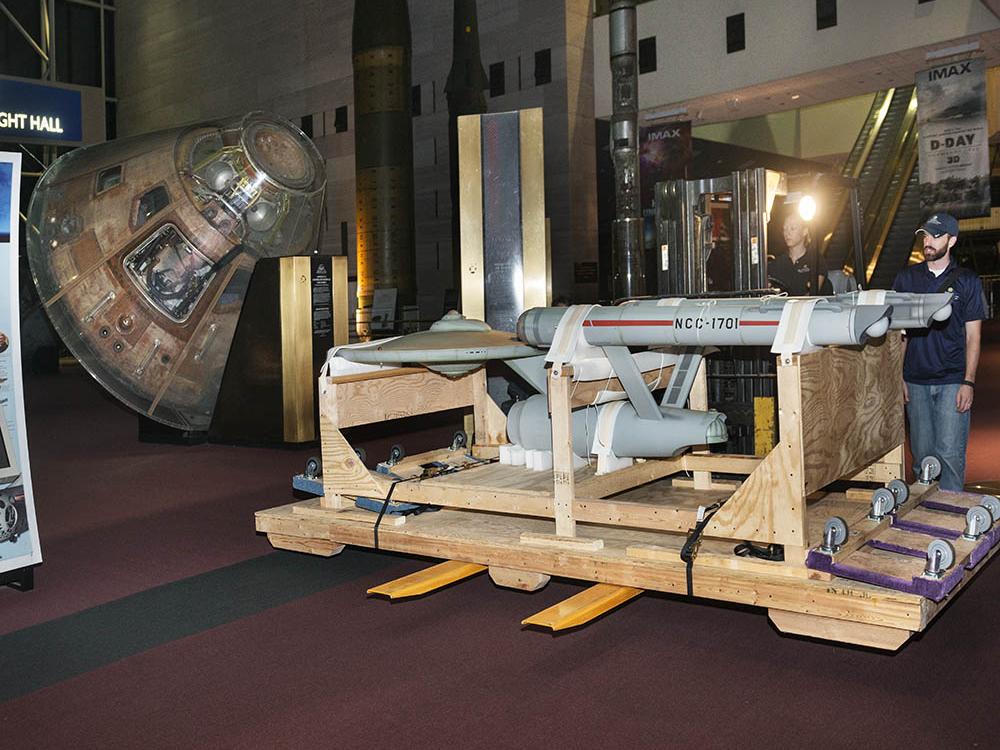
Advising on the Star Trek Starship Enterprise
Dec 30, 2014
By Margaret A. Weitekamp

Dec 30, 2014
By Margaret A. Weitekamp
Who do you call when you need to know everything there is to know about the Star Trek starship Enterprise? As the curator for that artifact—the original 11-foot model used in filming the Star Trek television program that aired from 1966 until 1969—I’ve spent a lot of time thinking and learning about Star Trek. The Museum has a lot of source material to rely upon: the acquisition, restoration, and exhibit record for this artifact stands at more than 1000 pages (and growing). In fact, I hired an intern two summers ago just to create a comprehensive index for that record so that I could know, for certain, whether I had checked every relevant document in it when searching for an answer. That review of the Museum’s records was a part of the move of the model that I have been planning for several years.
This fall, in September 2014, the Museum moved the Star Trek starship Enterprise studio model to the Emil Buehler Conservation Laboratory at the Museum’s Steven F. Udvar-Hazy Center, in Chantilly, Virginia, in preparation for its new display location in the Boeing Milestones of Flight Hall in 2016. Before it goes back on display in July 2016, the model needs some care and treatment.
To support that effort, the Museum has invited a special advisory committee of industry experts to offer information, research, and advice to help the Museum make the final aesthetic and structural decisions about the conservation and display of this cultural icon. The special advisors are a “Who’s Who” in the industry, and I’m delighted that they have agreed to help. To start our work, we’ve already held an initial video teleconference, which resulted in this fun “Brady Bunch” photo of us all.
The special advisory committee includes (in alphabetical order):
Doug Drexler Doug Drexler is an Academy Award-winning visual effects artist, designer, sculptor, illustrator, and makeup artist. His credits include Star Trek: The Next Generation, Deep Space Nine, Voyager, Enterprise, and subsequent Star Trek films. He is also known for designing the NX-01 Enterprise and the Enterprise J.
John Goodson John Goodson is a studio model maker and digital modeling artist for Industrial Light & Magic (ILM) who worked on four Star Trek films. He was first a model maker on Star Trek VI and then became the model supervisor for Star Trek Generations and Star Trek: First Contact. Gary Kerr A well-known hobby industry designer, archivist, and author, Gary Kerr consulted for CBS on the production of the 2006 remastered Star Trek: The Original Series, for the CBS Digital team.
Mike and Denise Okuda Michael Okuda was the lead graphic designer for four Star Trek TV shows and seven Trek movies. Denise Okuda was a graphic artist and video coordinator for the show. They are the authors of the Star Trek Encyclopedia and other Trek reference works. Mike and Denise recently served as technical consultants for the HD remastering of the original Star Trek series and Star Trek: The Next Generation.
Andrew Probert Andrew Probert is an artist who is best known for designing the USS Enterprise for Star Trek: The Motion Picture and the Enterprise-D for Star Trek: The Next Generation.
Adam Schneider A Star Trek studio model collector, Schneider restored the Shuttle Craft Galileo, a full-size prop from the original Star Trek series. The Galileo prop is now on display at the NASA Johnson Space Center’s visitor’s center in Houston, Texas.
Rick Sternbach Richard Sternbach is an illustrator who is best known for his space illustrations and his work on the Star Trek television series, which began with Star Trek: The Motion Picture in 1978.
John Van Citters The Vice President for Product Development at CBS Consumer Products, Van Citters has worked on Star Trek for 16 years.
As an artifact, the Star Trek starship Enterprise studio model has been treated three times during its history at the Museum: in 1974, 1984, and 1991. It has not had any significant treatment other than basic dusting, however, since 2000. The current work comes after years of internal planning; I have been researching and organizing this relocation of the Star Trek starship Enterprise studio model since 2011. You can see the model in person in the Conservation Lab during the Udvar-Hazy Center Open House on Saturday, January 24th. I’ll be on site all day, talking about the model’s history and its future. Or check back here. The public will be kept apprised of the Museum’s progress on the artifact conservation via the Museum website and other social media platforms.

We rely on the generous support of donors, sponsors, members, and other benefactors to share the history and impact of aviation and spaceflight, educate the public, and inspire future generations. With your help, we can continue to preserve and safeguard the world’s most comprehensive collection of artifacts representing the great achievements of flight and space exploration.
We rely on the generous support of donors, sponsors, members, and other benefactors to share the history and impact of aviation and spaceflight, educate the public, and inspire future generations. With your help, we can continue to preserve and safeguard the world’s most comprehensive collection of artifacts representing the great achievements of flight and space exploration.